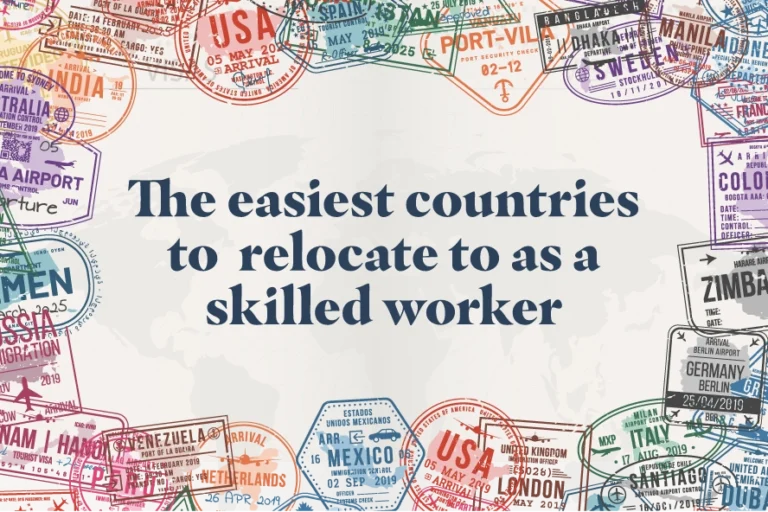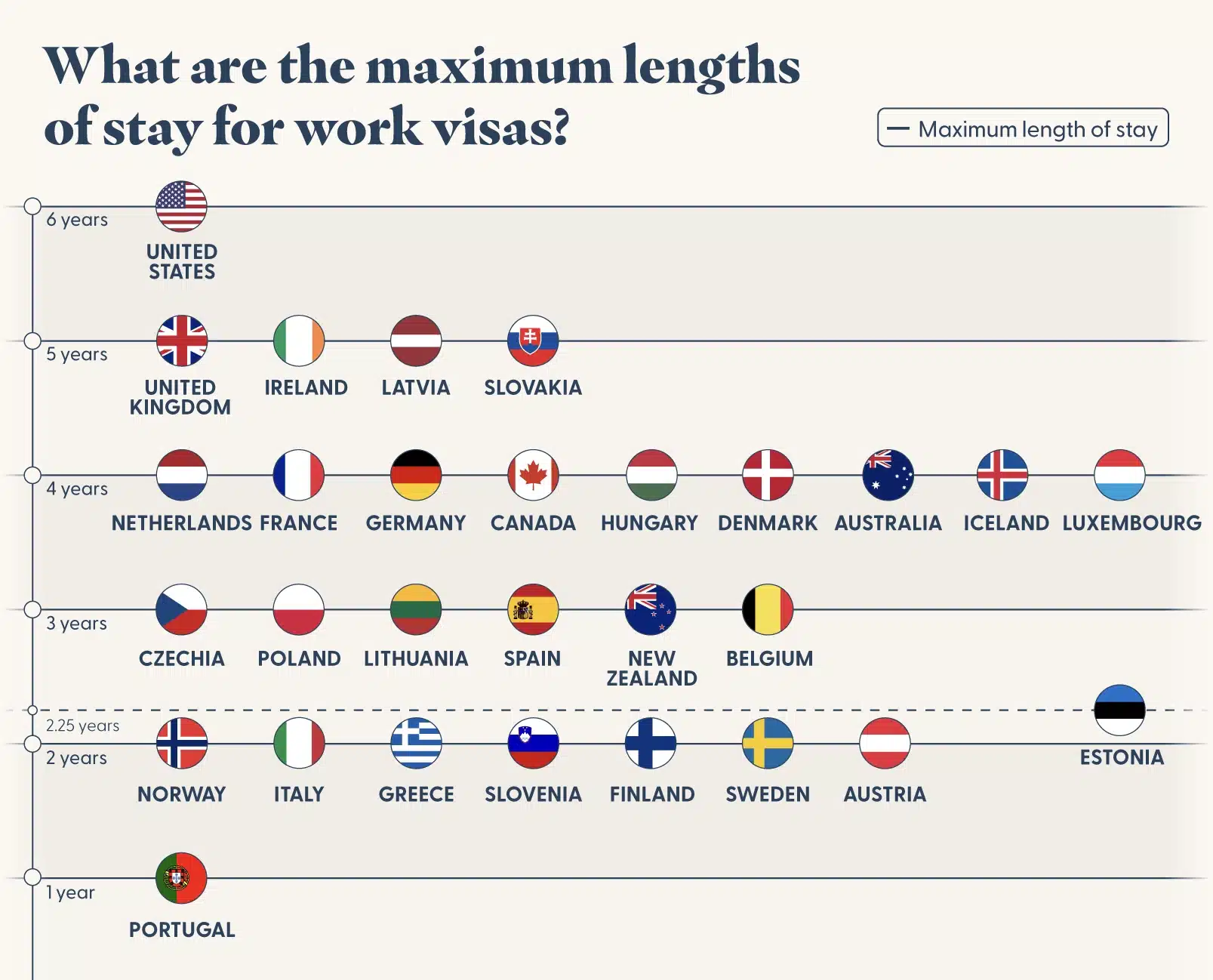Worker visas allow people to relocate to another country temporarily for work and can provide many employment opportunities.
The UK receives around 6,000 skilled worker visa applications every month [1], but how does this compare to other countries?
From lengthy maximum stays in the United States to Italy’s inexpensive application fees, which country’s worker visa offers applicants the most straightforward entry route?
Key findings
- Latvia ranks as the easiest country for skilled worker visas, with a low application fee of £83 and a short processing time of ten working days.
- Ireland and Iceland follow closely, offering relatively quick processing times and accessible salary requirements.
- The UK ranks seventh, requiring a minimum salary of £38,700 and an application fee of £1,420, making it one of the more expensive options.
- The United States offers the longest maximum visa duration (6+ years) but ranks sixth due to processing times and costs.
- Italy offers the most affordable work visa at £41, while Australia has the highest fee at £1,569 and the longest processing time (90% of applications processed in six months).
- Kazakhstan has the highest UK visa success rate (99.52%), while Pakistan has the lowest (82.39%) among the top 20 countries for UK entry clearance.
- Canada issues the most work visas among OECD countries, granting nearly 240,000 in 2023.
Which countries are the easiest to relocate to on a worker visa?
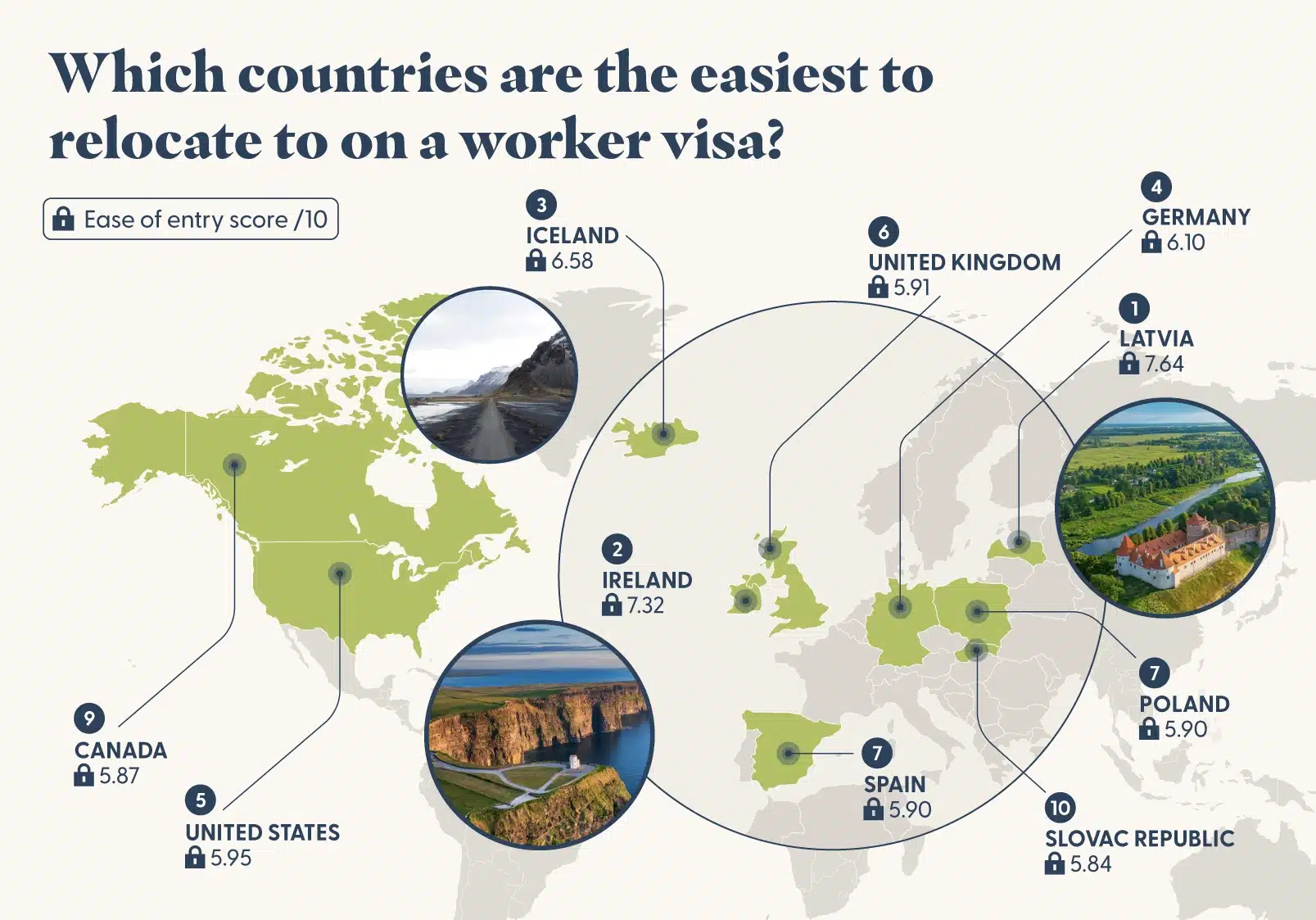
| Rank | Country | Visa Name | Average processing time (months) | Application fee | Number of applications granted | Minimum salary required | Maximum length of stay (years) | Average annual wage (2023) | Ease of entry score |
|---|---|---|---|---|---|---|---|---|---|
| 1 | Latvia | EU Blue Card | 0.3 | £83 | 419 | £20,508 | 5 | £30,652 | 7.64 |
| 2 | Ireland | Employment visa | 1.8 | £83 | 30,981 | £28,205 | 5 | £44,916 | 7.32 |
| 3 | Iceland | Residence permit for employment | 3 | £91 | – | £16,973 | 4 | £69,120 | 6.58 |
| 4 | Germany | EU Blue Card | 3 | £83 | 69,353 | £37,530 | 4 | £51,988 | 6.10 |
| 5 | United States | H-1B visa | 3.5 | £162 | 85,000 | – | 6 | £63,343 | 5.95 |
| 6 | United Kingdom | Skilled Worker visa | 0.7 | £1,420 | 54,900 | £38,700 | 5 | £45,555 | 5.91 |
| 7 | Spain | EU Blue Card | 0.7 | £74 | 370 | £32,179 | 3 | £40,589 | 5.90 |
| 7 | Poland | EU Blue Card | 2 | £102 | 7,402 | £22,794 | 3 | £32,456 | 5.90 |
| 9 | Canada | Work permit (from outside Canada) | 3.5 | £86 | 239,646 | – | 4 | £52,350 | 5.87 |
| 10 | Slovak Republic | EU Blue Card | 1 | £207 | 24 | £17,059 | 5 | £25,090 | 5.84 |
‘-’ refers to unavailable data due to lack of reporting
*All data is from 2023, with the exception of the United Kingdom (April 2024 – Jan 2025)
1. Latvia – 7.64/10 ease of entry score
Latvia is one of 25 EU countries offering the EU Blue Card visa, which allows highly skilled workers to reside and work in their chosen country. It costs around £83 to apply for an EU Blue Card in Latvia, and applicants need only earn around £20,500 per year to qualify.
Latvia’s national law states that all EU Blue Cards should be issued within ten working days, which is the quickest processing time on the list. Successful applicants can reside and work in Latvia for up to five years, the third-longest stay period among listed countries.
On average, workers in Latvia earn an annual wage of approximately £30,650. Some of the biggest industries in the country include transportation, wood and forestry products, financial services, and textiles.
2. Ireland – 7.32/10 ease of entry score
Ireland follows closely behind, earning an ease of entry score of 7.32 out of ten. Pharmaceuticals, beverages and brewing, education, and computer software are some of the most prominent industries in the country, and workers earn just under £45,000 per year, on average.
Similar to Latvia, it costs around £83 to apply for an employment visa in Ireland. The maximum length of stay on this visa is five years. However, the application process takes significantly longer, averaging around eight weeks.
To qualify for an Irish employment visa, applicants must earn approximately £28,205. In 2023, Ireland issued over 30,980 work permits, equating to a 95% approval rate. The highest number of visas were granted to citizens of India, the Philippines, Brazil, Pakistan, and China [2].
3. Iceland – 6.58/10 ease of entry score
Iceland’s residence permit for employment allows applicants to stay in the country for up to four years. This applies to those relocating to the country for a job requiring specialist knowledge, with university, vocational, artistic, or technical education necessary.
Applicants must earn an annual wage of just under £17,000 to qualify for Iceland’s work visa, making it an easier threshold to meet. The application fee is approximately £91, and the approval process can take up to 90 days (three months).
Icelandic workers earn an impressive annual wage of approximately £69,120 on average. The country’s biggest industries include fishing, aluminium smelting, tourism, and energy.
What are the average processing times for work visas?
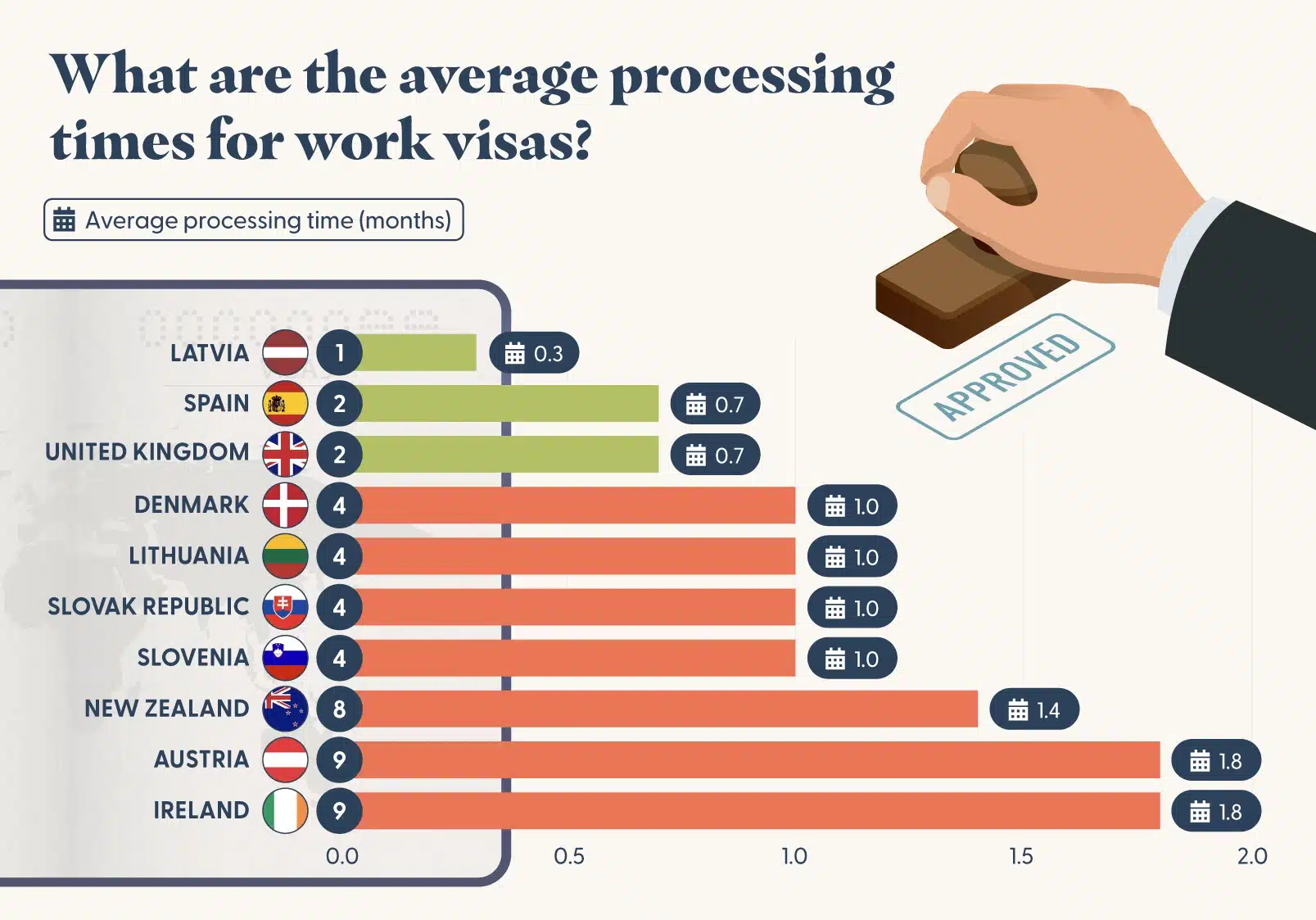
As mentioned, Latvia has the quickest average processing time at just ten working days. However, it’s important to note that this is only the time to issue the visa. Once the visa has been issued, the production of the card will take a further ten working days in general or two working days on an accelerated procedure.
Most countries in our analysis, including Belgium, France, Hungary, Luxembourg, and Sweden, have an average visa processing time of three months. Canada and the U.S. follow closely behind, taking an average of three and a half months.
Australia has the longest average visa processing time, at six months. However, this is the maximum average time, and visas may be processed more quickly. 50% of applicants for Australia’s Temporary Skill Shortage (TSS) Visa are processed within around two months (61 days), with 90% being processed within six months.
What are the application fees for work visas?
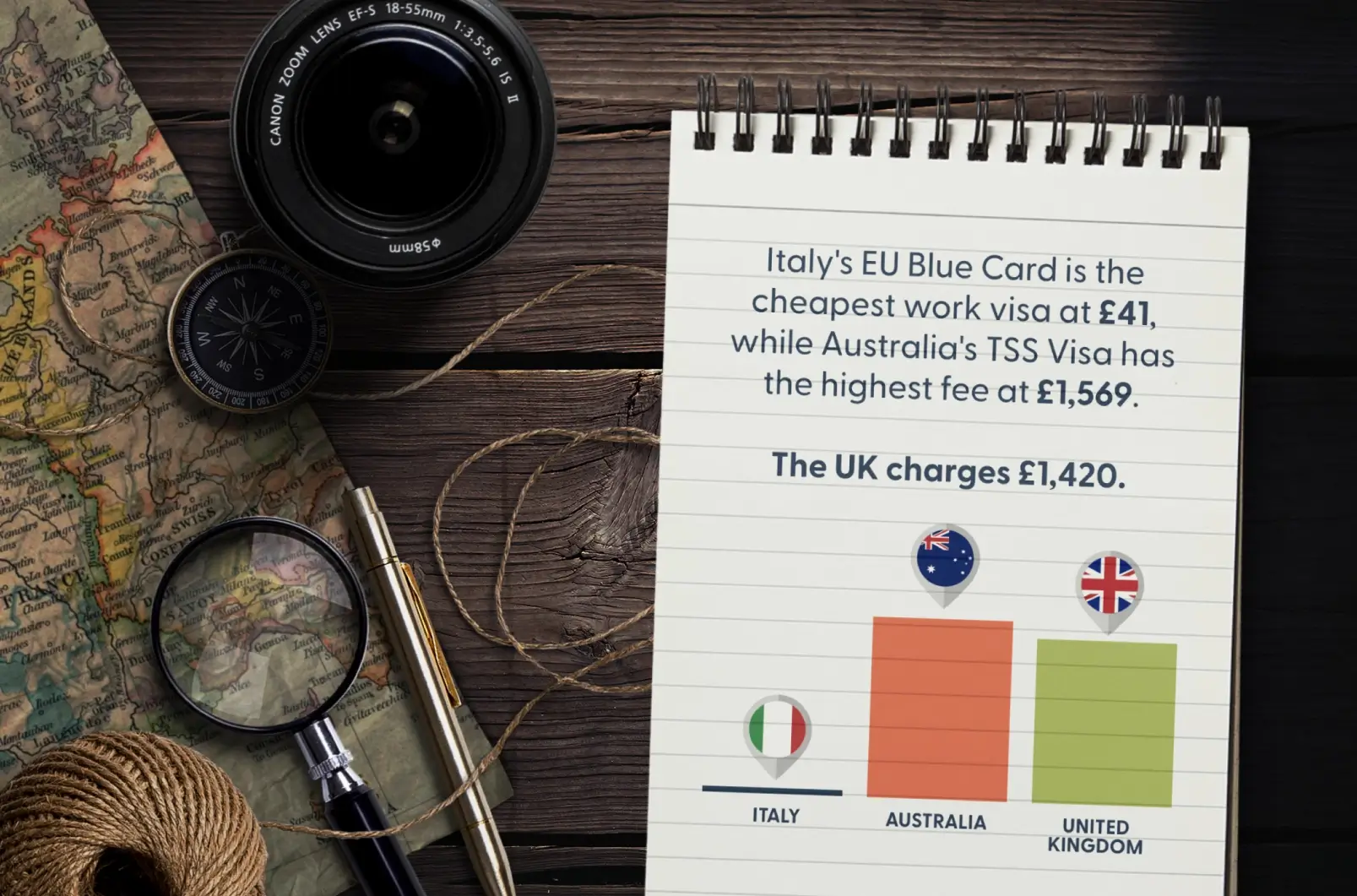
Italy’s EU Blue Card is the cheapest work visa to apply for, at just £41. Successful applicants can also renew their card for the same price once the initial two-year validity period has ended. If a visa holder’s card is lost or stolen, it can be replaced for free.
Application fees for EU Blue Cards vary considerably depending on the country of work. The Netherlands charges the most expensive application fee for one of these visas at £335. The initial four-year validity period of the Netherlands’ EU Blue Card can be extended for the same price.
Australia’s TSS Visa has one of the longest average processing times and the most expensive application fee, at £1,569. The same charge applies for additional applicants over 18, while those under 18 can be added for around £388.
What are the minimum salaries required for work visas?
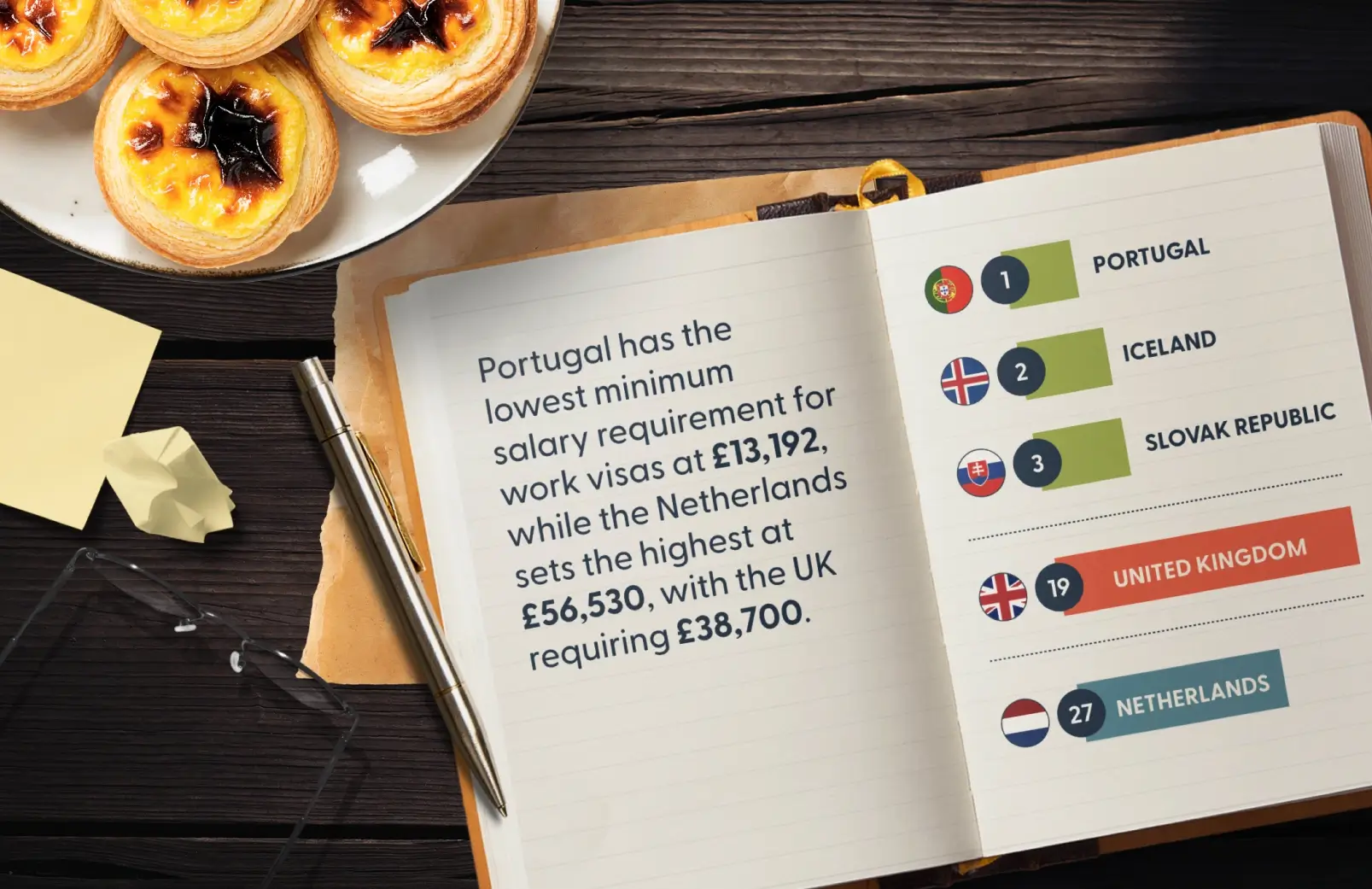
| Rank | Country | Visa Name | Minimum salary required |
|---|---|---|---|
| 1 | Portugal | EU Blue Card | £13,192 |
| 2 | Iceland | Residence permit for employment | £16,973 |
| 3 | Slovak Republic | EU Blue Card | £17,059 |
| 4 | Hungary | EU Blue Card | £19,144 |
| 5 | Latvia | EU Blue Card | £20,508 |
| 6 | Poland | EU Blue Card | £22,794 |
| 7 | Estonia | EU Blue Card | £25,144 |
| 8 | Czechia | EU Blue Card | £25,788 |
| 9 | Greece | EU Blue Card | £26,445 |
| 10 | Italy | EU Blue Card | £27,753 |
| 11 | New Zealand | Accredited Employer Work Visa | £27,960 |
| 12 | Ireland | Employment visa | £28,205 |
| 13 | Lithuania | EU Blue Card | £31,457 |
| 14 | Norway | Residence permit for work | £31,950 |
| 15 | Spain | EU Blue Card | £32,179 |
| 16 | Australia | Temporary Skill Shortage (TSS) (subclass 482) visa
Temporary Work (Skilled) (subclass 457) visa |
£36,740 |
| 17 | Germany | EU Blue Card | £37,530 |
| 18 | United Kingdom | Skilled Worker visa | £38,700 |
| 19 | Austria | EU Blue Card | £39,665 |
| 20 | Slovenia | EU Blue Card | £41,811 |
| 21 | France | EU Blue Card | £44,625 |
| 22 | Luxembourg | EU Blue Card | £48,838 |
| 23 | Sweden | EU Blue Card | £49,614 |
| 24 | Belgium | EU Blue Card | £50,559 |
| 25 | Finland | EU Blue Card | £51,854 |
| 26 | Netherlands | EU Blue Card | £56,530 |
Portugal has the lowest minimum required salary, at just over £13,190. In addition to meeting this salary threshold, those applying for Portugal’s EU Blue Card must provide other documents, such as a valid work contract or binding job offer lasting at least one year, proof of sickness insurance, and travel documents.
Just like application fees, the salary thresholds for EU Blue Cards can also differ depending on the country of work. The Netherlands requires applicants to earn a minimum wage of £56,530 per year, making it the highest threshold for both the EU Blue Card Scheme and overall.
The UK has the highest minimum required salary outside the EU, at £38,700. This threshold may be adjusted if current visa holders extend their Skilled Worker Visa or have a new job or employer.
What are the maximum lengths of stay for work visas?
The U.S. offers the longest validity period for a work visa. The H-1B Visa initially allows applicants to reside and work in the U.S. for up to six years. However, this can be extended in one-year increments. In addition, only time physically spent in the U.S. counts towards the six-year validity period. Any time spent outside the country exceeding 24 hours doesn’t count towards the six-year limit.
The validity period of EU Blue Cards varies from one year to five years, depending on the country. Latvia and Slovakia are the only EU countries that allow visa holders to stay for a maximum of five years. All other countries in the scheme have validity periods ranging from two to four years, except Portugal, which only offers one year.
Which OECD countries grant the most work visas?
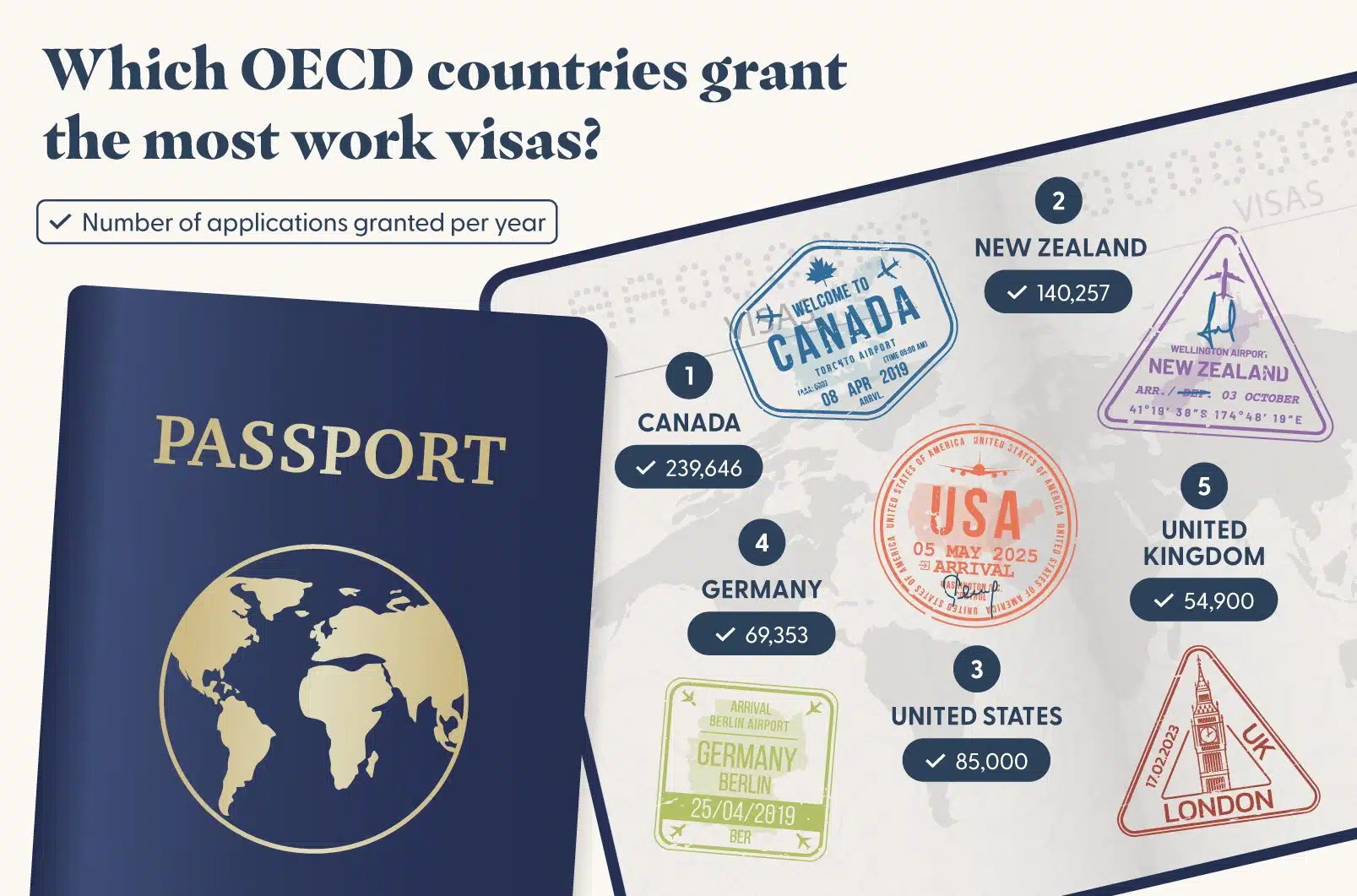
In recent years, Canada has granted the most work visas of all OECD countries. Just under 240,000 applicants successfully gained a Canadian work visa in 2023, an increase of around 120% since 2018, when just less than 109,000 visas were granted [3].
To date, New Zealand has granted over 140,250 Accredited Employer Work Visas. This visa allows people to reside and work in New Zealand for a maximum of five years and costs around £699 to apply for. 80% of applications are processed within 6 weeks, making it a relatively quick process.
In 2023, Hungary granted just 17 EU Blue Cards, placing it at the bottom of the rankings. However, a further 99 people were able to renew their visas, while seven individuals chose to withdraw their applications.
What are the average annual wages in OECD countries?
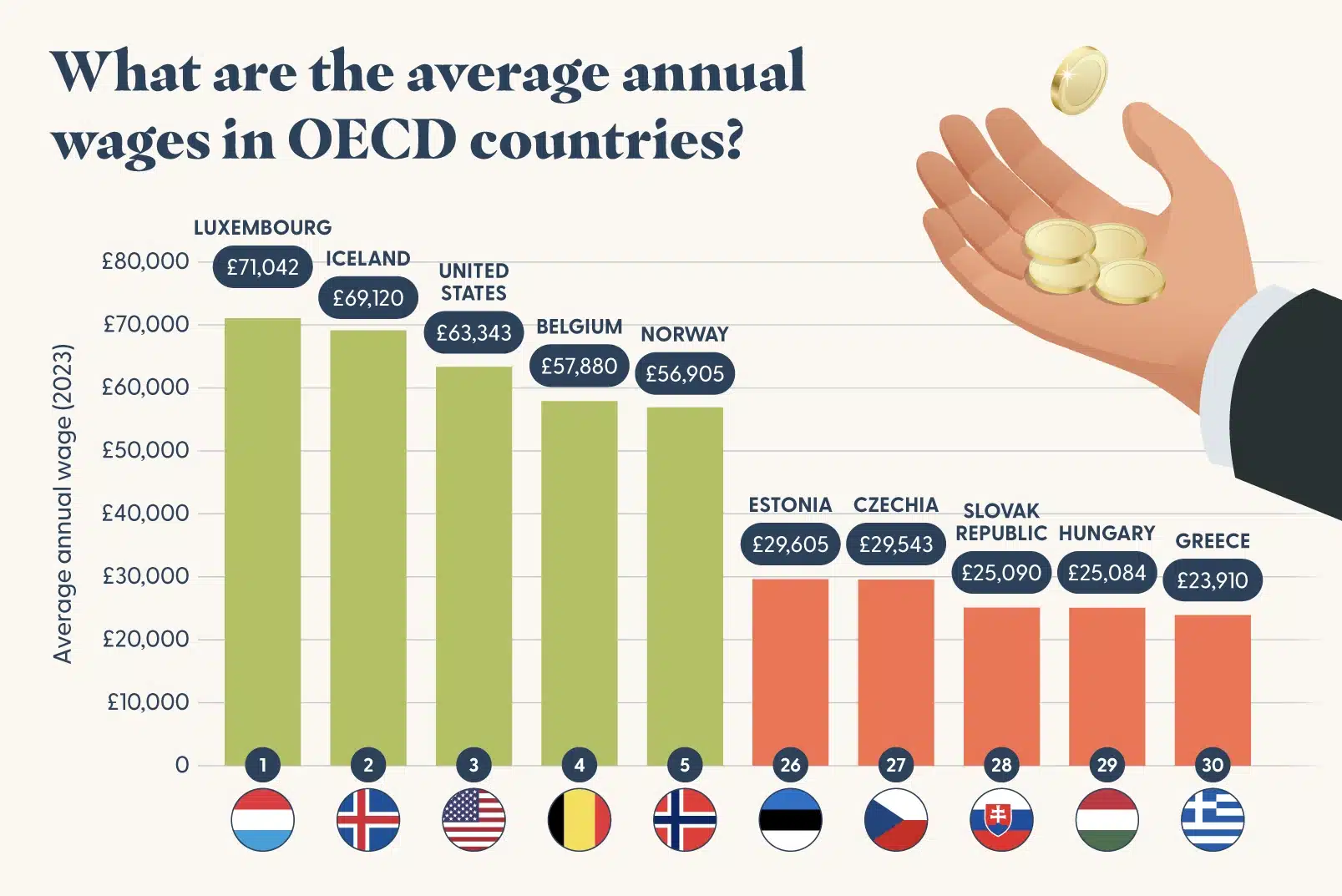
Luxembourg provides workers with the highest average salary across OECD countries, at just over £71,040 per year. This is around £22,200 more than the minimum required salary for work visa applicants (£48,838). Agriculture is a prominent industry in the country due to its vast farmland and valley landscape. Some other popular industries include banking, aerospace, construction, and steel.
There are eight OECD countries with average annual wages ranging from £40,000 to £50,000, such as France, Finland, Slovenia, and Spain. Eight countries on the list have workers who earn between £50,000 and £60,000 per year on average, including Germany, Denmark, and Norway.
Greece has the lowest average salary, at less than £24,000 annually. This is around £2,445 less than the minimum required salary for work visa applicants (£26,445). In addition to its prominent tourism industry, Greece is also known for tobacco processing, textiles, chemicals, and mining.
Which countries are granted the most UK entry clearance visas?
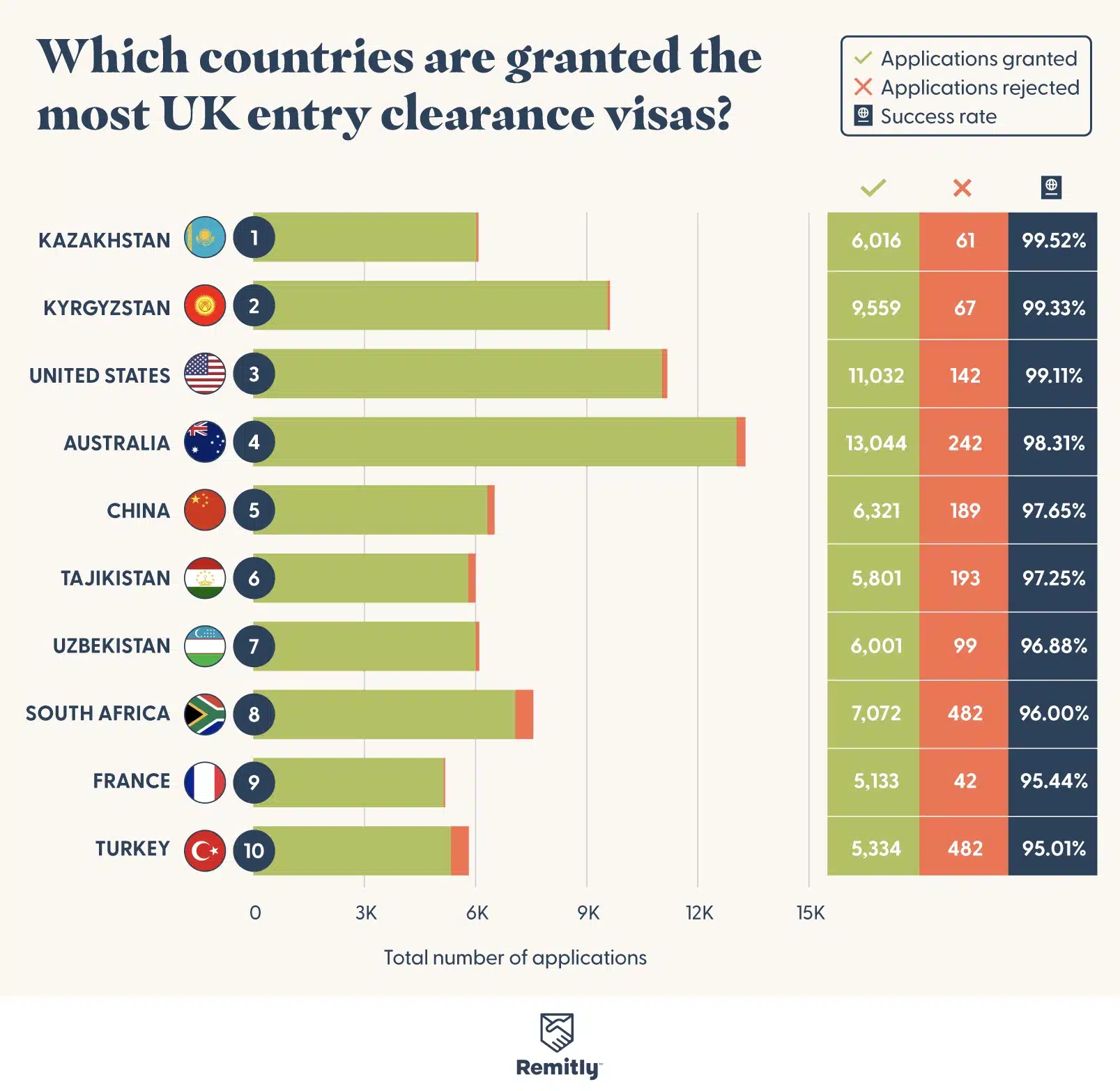
| Rank | Country | Total number of applications | Number of applications granted | Number of applications refused | Success rate |
|---|---|---|---|---|---|
| 1 | Kazakhstan | 6,045 | 6,016 | 61 | 99.52% |
| 2 | Kyrgyzstan | 9,623 | 9,559 | 67 | 99.33% |
| 3 | United States | 11,131 | 11,032 | 142 | 99.11% |
| 4 | Australia | 13,268 | 13,044 | 242 | 98.31% |
| 5 | China | 6,473 | 6,321 | 189 | 97.65% |
| 6 | Tajikistan | 5,965 | 5,801 | 193 | 97.25% |
| 7 | Uzbekistan | 6,194 | 6,001 | 99 | 96.88% |
| 8 | South Africa | 7,367 | 7,072 | 482 | 96.00% |
| 9 | France | 5,378 | 5,133 | 42 | 95.44% |
| 10 | Turkey | 5,614 | 5,334 | 482 | 95.01% |
| 11 | Philippines | 25,775 | 24,254 | 1,859 | 94.10% |
| 12 | India | 110,482 | 103,007 | 10,526 | 93.23% |
| 13 | Sri Lanka | 11,447 | 10,492 | 1,332 | 91.66% |
| 14 | Zimbabwe | 29,183 | 26,623 | 4,231 | 91.23% |
| 15 | Kenya | 6,042 | 5,361 | 858 | 88.73% |
| 16 | Nepal | 5,855 | 5,167 | 685 | 88.25% |
| 17 | Nigeria | 45,792 | 40,136 | 9,417 | 87.65% |
| 18 | Ghana | 19,791 | 16,636 | 4,551 | 84.06% |
| 19 | Bangladesh | 17,545 | 14,500 | 4,164 | 82.64% |
| 20 | Pakistan | 55,487 | 45,718 | 10,218 | 82.39% |
Note: this data reflects the top 20 countries with the highest application success rates. Although success rates may be calculated for more countries, the Government doesn’t disclose this data. The Government also does not highlight the specific reasons for rejection, however, some common causes are incorrect documentation, criminal records, and insufficient financial support.
1. Kazakhstan – 99.52% success rate
Kazakhstan tops the list with a 99.52% success rate, meaning applicants are near-guaranteed to have their UK visa granted. In 2024, 6,045 Kazakhstan citizens applied for entry clearance in the UK, with 6,016 being successful and just 61 having their applications refused.
2. Kyrgyzstan – 99.33% success rate
Kyrgyzstan follows closely behind, with 99.33% of applicants being granted entry into the UK in 2024. 9,623 citizens of the Central Asian country applied for a UK visa, and just 67 of them had their application refused. This means 9,559 people successfully gained entry to the UK.
3. United States – 99.11% success rate
11,131 U.S. citizens applied for entry clearance to the UK in 2024. 142 of these people had their applications refused, while 11,032 were successful, equating to 99.11% of the applicants.
Methodology:
We used OECD countries to create a seed list of locations that offer work or employment visas. Countries with active conflicts were not reviewed in this analysis.
Next, we used individual sites to find the average processing times, application fees, minimum required salaries, maximum lengths of stay and the number of applications granted for each country’s visa. All data is correct as of 25 February 2025.
We then used OECD data to source the average annual wages in each country in 2023. All currencies were converted on 25 February 2025.
Next, we gave each of the six factors a normalised score out of ten before taking an average across all factors to form our ease of entry score.
Finally, we used gov.uk to discover the successful UK entry clearance application rate by country.
